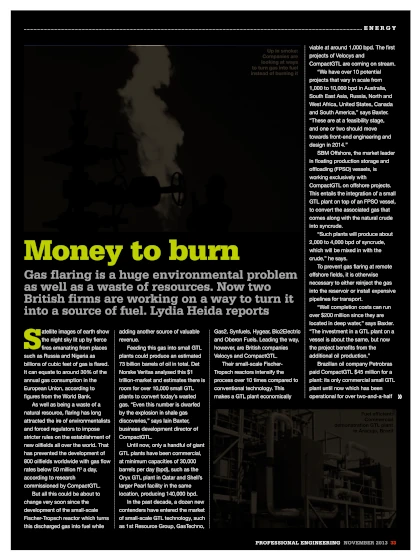Money to burn
Gas flaring is a huge environmental problem as well as a waste of resources. Now two british firms are working on a way to turn it into a source of fuel. lydia Heida reports.
Satellite images of earth show the night sky lit up by fierce fires emanating from places such as Russia and Nigeria as billions of cubic feet of gas is flared. It can equate to around 30% of the annual gas consumption in the European Union, according to figures from the World Bank.
As well as being a waste of a natural resource, flaring has long attracted the ire of environmentalists and forced regulators to impose stricter rules on the establishment of new oilfields all over the world.

$1 trillion-market
That has prevented the development of 800 oilfields worldwide with gas flow rates below 50 million ft3 a day, according to research commissioned by CompactGTL. But all this could be about to change very soon since the development of the small-scale Fischer-Tropsch reactor which turns this discharged gas into fuel while adding another source of valuable revenue.
Feeding this gas into small GTL plants could produce an estimated 73 billion barrels of oil in total. Det Norske Veritas analysed this $1 trillion-market and estimates there is room for over 10,000 small GTL plants to convert today’s wasted gas. “Even this number is dwarfed by the explosion in shale gas discoveries,” says Iain Baxter, business development director of CompactGTL.
Until now, only a handful of giant GTL plants have been commercial, at minimum capacities of 30,000 barrels per day (bpd), such as the Oryx GTL plant in Qatar and Shell’s larger Pearl facility in the same location, producing 140,000 bpd.
In the past decade, a dozen new contenders have entered the market of small-scale GTL technology, such as 1st Resource Group, GasTechno, Gas2, Synfuels, Hygear, Bio2Electric and Oberon Fuels.
Gas flaring
Leading the way, however, are British companies Velocys and CompactGTL. Their small-scale Fischer-Tropsch reactors intensify the process over 10 times compared to conventional technology.
This makes a GTL plant economically viable at around 1,000 bpd. The first projects of Velocys and CompactGTL are coming on stream.
“We have over 10 potential projects that vary in scale from 1,000 to 10,000 bpd in Australia, South East Asia, Russia, North and West Africa, United States, Canada and South America,” says Baxter. “These are at a feasibility stage, and one or two should move towards front-end engineering and design in 2014.”
SBM Offshore, the market leader in floating production storage and offloading (FPSO) vessels, is working exclusively with CompactGTL on offshore projects. This entails the integration of a small GTL plant on top of an FPSO vessel, to convert the associated gas that comes along with the natural crude into syncrude.
“Such plants will produce about 2,000 to 4,000 bpd of syncrude, which will be mixed in with the crude,” he says. To prevent gas flaring at remote offshore fields, it is otherwise necessary to either reinject the gas into the reservoir or install expensive pipelines for transport.
Offshore GTL projects
“Well completion costs can run over $200 million since they are located in deep water,” says Baxter. “The investment in a GTL plant on a vessel is about the same, but now the project benefits from the additional oil production.”
Brazilian oil company Petrobras paid CompactGTL $45 million for a plant: its only commercial small GTL plant until now which has been operational for over two-and-a-halfyears at Aracuja in Brazil.
Last year, the construction of such a plant on a vessel was approved in principle by Det Norske Veritas. However, Petrobras has postponed moving offshore GTL projects into front-end engineering and design, after cutting back on upstream investments. (...)
Publication: Professional Engineering Magazine
Date: October 2013
Would you like to read the entire article? If so, please let me know!
CONTACT MEScarce by nature | Recycling of rare earth metals
Read More

Weight-lifting record

Carbon Recycling International: turning CO2 into fuel
Interested in working together?
I'd love to hear from you.